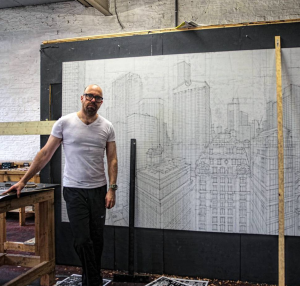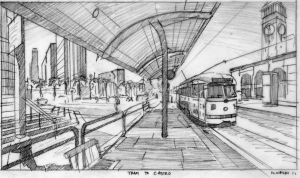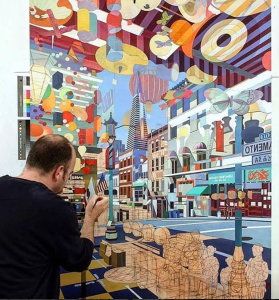 I am happy to share the work of Nathan Walsh, talented English painter represented by Bernarducci Meisel Gallery, who explores the complex world of cityscape where he aims “to present a painted world which in some ways resembles the world we live in”. His paintings and his process to create them are fascinating and he was generous enough to take some time telling me about it. Thanks Nathan!
I am happy to share the work of Nathan Walsh, talented English painter represented by Bernarducci Meisel Gallery, who explores the complex world of cityscape where he aims “to present a painted world which in some ways resembles the world we live in”. His paintings and his process to create them are fascinating and he was generous enough to take some time telling me about it. Thanks Nathan!
Nathan, tell us about yourself: where do you live? What is your background?
I live and work in the medieval city of York, in the north of England. It’s a quiet place which allows me to get on with my work undisturbed. I’ve been painting full time for about 9 years, before that I split my time teaching at a local art college for half the week and painting for the rest of it. I did my first degree in Liverpool then my Masters studying under the renowned realist painter Clive Head. My relationship with Clive has been significant in terms of my evolution as painter both in a practical and theoretical sense.
Tell us about your art and your artistic path, how did you become the painter you are today?
If you choose to become a contemporary realist painter then I believe it’s important that you attempt to add something new to the movement. Merely repeating the efforts of the past masters is of no interest to me, whether that’s paying homage to the pioneering Photorealists of the 1970s or making Neoclassical works in the style of Bouguereau.
I see my practice as a combination of painting strategies which “samples” various other artists and movements. By mixing different approaches and techniques together the goal is to present a visual language which celebrates the richness of art history without resorting to revivalism.
Whilst my subject matter is of secondary importance to my methodology I have felt naturally drawn to the urban landscape for a number of years. The city is in a constant state of flux and seems to offer unlimited possibilities for exploration and experimentation. The act of painting can be seen as an attempt to ‘fix’ this flux and offer a new re-ordered reality. This reality need not be dependent on the laws that govern our own world but establish its own new set of attributes.
Who are your main influencers?
My influences are many and varied, but crucially they are all connected by an engagement with materials. If I had to pick a current top ten of people I’m looking at then how about this: Bonnard ; Vuillard ; Turner ; Tapies ; Lopez Garcia ; De Kooning ; Sickert ; Constable ; Kiefer ; Whistler.
Having said that if you asked me tomorrow then the list would be likely to change. I think my own activity is driven partly by a passion for other artists work, and whilst certainly in the past that has led to imitative work I’m hopeful that the work I’m making now is more celebratory.
A few of Nathan’s influencers
Your drawings and sense of perspective are fascinating. Can you describe your artistic process?
Travel is normally the starting point for a painting or body of work. I take photographs and make drawings on site, normally at different times of day and under different lighting conditions. The drawings are small and scruffy but are a direct link to that particular experience. I did make a painting once based on someone else’s photography once but the results were terrible. I believe that the closer you can connect with that initial point in time once you’re back in the studio the richer the results are likely to be. I try not to have any preconceived ideas of what I’m going to make or how I’ll make it but tend just to amble around in a fairly haphazard way.
 When I return to England I sift through the material I’ve collected and just spend a few days thinking about it and letting the possibilities settle. From this point I will make a series of postcard sized drawings, mapping out how an idea might function. I will pin these drawings up on the studio and just live with them for a while. Over time most of them will get rejected and destroyed. What’s left makes it to the final cut and becomes a larger scale work.
When I return to England I sift through the material I’ve collected and just spend a few days thinking about it and letting the possibilities settle. From this point I will make a series of postcard sized drawings, mapping out how an idea might function. I will pin these drawings up on the studio and just live with them for a while. Over time most of them will get rejected and destroyed. What’s left makes it to the final cut and becomes a larger scale work.
 Once I’ve decided on the size of the proposed work (this decision is made based on the size of the painting and the specific subject matter in relation to my own physicality in the studio). I then start drawing elements in freehand in response to the postcard sized drawing. I don’t use any kind of projection or tracing as it leads to a predetermined outcome. Not that I have anything against artists who do employ such methods, it just doesn’t work for me.
Once I’ve decided on the size of the proposed work (this decision is made based on the size of the painting and the specific subject matter in relation to my own physicality in the studio). I then start drawing elements in freehand in response to the postcard sized drawing. I don’t use any kind of projection or tracing as it leads to a predetermined outcome. Not that I have anything against artists who do employ such methods, it just doesn’t work for me.
I use a series of perspectival drawing systems to draw out my subject. It’s a mix of approaches which tends to change from painting to painting which helps keep things open and dynamic. I don’t believe you reach a point as an artist of finding an optimum methodology or process for making work. If you settle on a particular strategy the work can become formulaic and ultimately mundane very quickly.
How do you get inspired for your new creations?
I spend a lot of my time looking at books, finding new experiences and talking to other artists. This I believe helps keep an open mind and suggests ways of extending the pictorial language that I’m exploring. I think carefully before I start a new work about how I can make a more complex and richer painting instead of taking the easy option and making something I’ve done before.
Do you have an anecdote that you’d like to share?
 Perhaps the most useful anecdotal advice I can give relates to a trip around the United States I made in 2011. I’d arrived in Chicago which was somewhere I’d been keen to visit for a long time but the weather was atrocious. I had in mind making a piece of work which explored the ocean drive on a clear crisp day. After complaining to my partner that I was now unable to make what I originally wanted I decided to brave the weather and explore the city on foot. What resulted from this walked fuelled an entire series of works which were unexpected and represented a significant move forward in my practice. The lesson to be learnt was not to have a predetermined idea about you’re going to make and be open to your own individual experience. There is rich subject matter everywhere, you just need to attune yourself to it.
Perhaps the most useful anecdotal advice I can give relates to a trip around the United States I made in 2011. I’d arrived in Chicago which was somewhere I’d been keen to visit for a long time but the weather was atrocious. I had in mind making a piece of work which explored the ocean drive on a clear crisp day. After complaining to my partner that I was now unable to make what I originally wanted I decided to brave the weather and explore the city on foot. What resulted from this walked fuelled an entire series of works which were unexpected and represented a significant move forward in my practice. The lesson to be learnt was not to have a predetermined idea about you’re going to make and be open to your own individual experience. There is rich subject matter everywhere, you just need to attune yourself to it.
What is the question you’re asked the most?
“How long did that take you?” is the question I get most frequently asked. Second to that (which is far more annoying) and always come from other artists is “How do I go about getting gallery representation?”.
What is the question you’d like to be asked?
“Can you be a realist painter and still be relevant in 2017 or is anything you make an act of revivalism?” All realist painters face this dilemma, the first issue is becoming fully aware of it, then coming up with a strategy to answer it.
What are your projects for the coming months / year?
I’m currently trying to finish a large painting which has been ongoing for the past eighteen months and an even larger one which is still at the drawing stage. Both paintings will form the basis of a solo exhibition at the Bernarducci Meisel Gallery in New York in October 2017. In addition I’m making a series of drawings for an exhibition curated by Susan Meisel next April. I think this should be enough to keep me busy.
To know more and follow Nathan Walsh:
Website: nathanwalsh.net
Instagram @nathan_walsh_artist


